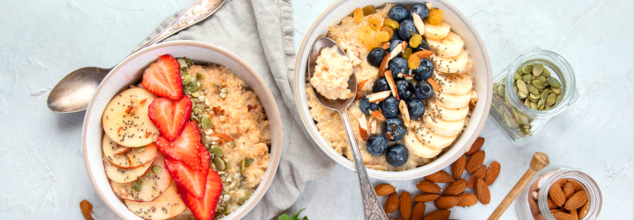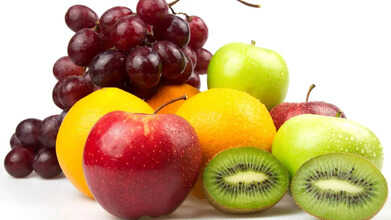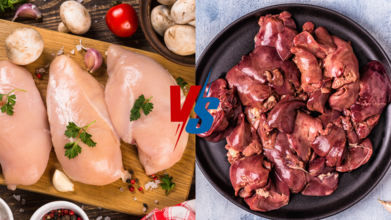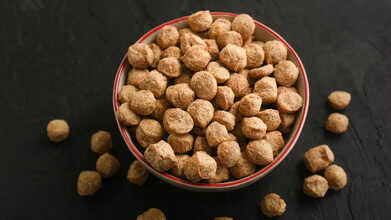- Health Conditions A-Z
- Health & Wellness
- Nutrition
- Fitness
- Health News
- Ayurveda
- Videos
- Medicine A-Z
- Parenting
- Web Stories
One Meal, Two Goals: Secret To Losing Or Gaining Weight With Same Ingredients

Image Credit: Canva
Nutrition plays a very important role in fitness, whether you want to lose or gain weight. What is interesting is that the same meal can be prepared for both objectives. My younger sister and I recently started on opposite journeys—she aimed to gain weight while I worked on losing it. Mornings became a shared ritual, starting with the same bowl of porridge. For me, it was skimmed milk and apples; for her, full cream milk and bananas. She counted steps on the treadmill while I counted reps with weights.
Despite our goals, our paths often crossed—sharing tips, motivating each other, and laughing over cheat days. Watching our bodies transform in opposite ways yet feeling united in spirit taught us that health isn't a one-size-fits-all journey—it's deeply personal yet beautifully shared.
It all comes down to portion control, ingredient choice, and mindful modification. This approach not only simplifies meal planning but also ensures a healthy and sustainable diet. Here's how the same Porridge (broken wheat) meal can serve two opposite goals effectively.
Weight loss or weight gain is not about calorie counting but about nutrient balance. A well-structured diet provides the right mix of carbohydrates, proteins, fats, and fiber to align with your body's needs. Let's explore how this balance shifts when targeting weight loss versus weight gain.
Weight Gain Meal (811.4 Calories)
This variant is high-calorie and nutrient-rich for muscle growth, and to give sustained energy. It includes the following:
- Raw Broken Wheat (Porridge): 50g (170.8 cal) – This provides complex carbohydrates, which can gradually release energy.
- Full Cream Milk: 200ml (172.8 cal) – It contains high levels of healthy fats and other nutrients.
- Banana: 100g (105.1 cal) – Provides a quick source of energy with its potassium content.
- Flax Seeds: 10g (44.3 cal) - omega-3 rich for the health of all tissues.
- Sesame Seeds: 10g (51.9 cal) - source of calcium, healthy fats, and calcium
- Almonds: 10g (60.9 cal) - source of protein, healthy fats, and satisfying crunch.
- Jaggery: 10g (35.3 cal) - a natural sweetener, which also contains minerals.
- Peanut Butter: 30g (170.1 cal) – High in protein and good fats, great for muscle building.
Macro Nutrient Breakdown
- Carbs: 83.9g
- Protein: 26.6g
- Fat: 41.5g
- Fiber: 14.4g
Weight Loss Meal (416.8 Calories)
This lighter version focuses on cutting unnecessary calories while retaining essential nutrients to keep you full and energized. The modifications include:
- Raw Broken Wheat (Porridge): 50g (170.8 cal) – Maintains the base for slow-releasing energy.
- Skimmed Milk: 200ml (70 cal) – Low-fat alternative to full cream milk.
- Apple: 100g (62.3 cal) – Low-calorie fruit rich in fiber and antioxidants.
- Flax Seeds: 5g (22.1 cal) – Amount reduced to reduce calories.
- Sesame Seeds: 5g (25.9 cal) – Just adds a hint of flavor without getting too fat-full.
- Almonds: 5g (30.4 cal) – Just enough to give that little protein kick.
- Jaggery: 10g (35.3 cal) – Natural sweetener in small amount.
Macronutrient Breakup
- Carbs: 67.3g
- Protein: 15.8g
- Fat: 8.4g
- Fiber: 9.7g
This version ensures a calorie deficit while still offering a nutritious and satisfying meal for those aiming to lose weight.
Also Read: You Might Not Need Ozempic Anymore To Lose Weight, Here's Why
How to Modify Ingredients for Your Goals
Mindful swaps and portioning are the magic to transform this dish. Adding calorie-rich ingredients such as full cream milk and peanut butter supports weight gain, while taking lighter alternatives, such as skimmed milk and apples, is helpful for losing weight.
Nutritional Content of Key Ingredients
- Porridge- Low glycemic index food helps stabilize blood sugar levels.
- Flax and Sesame Seeds- Rich in essential fatty acids and other micronutrients.
- Almonds- Provide protein and healthy fats in controlled portions.
- Jaggery- Provide a better sugar option instead of white sugar.
Expert Tips for Proper Weight Management
If one aims for weight loss, their meal must cause a calorie deficit. In case one wishes to gain weight, a calorie surplus should be present with the meal not excessively fat- or sugar-rich.
Regular meal times boost metabolism. For weight gain, use this meal in a calorie intake plan, while for weight loss, use it as a filling breakfast to curb the mid-morning cravings.
Weight loss involves burning more calories than are being consumed, thus using this meal with cardio or strength training activities. For weight gain, one would focus on resistance training to turn excess calories into muscle mass.
The beauty of this daliya meal lies in how adaptable it can be. One can be planning to lose some weight or maybe gain some by making the proper ingredient choices or adjusting the quantities. Thus, it becomes the perfect and healthiest choice according to one's needs. Thus, one's body would get enough nutrition and it would lead toward the achievement of the desired weights.
This Everyday Kitchen Staple May Help Your Lungs Battle Pollution

Credits: Canva
Air pollution is one of the leading environmental threats to health, affecting millions of people worldwide. Tiny airborne particles, known as PM2.5, are released by vehicles, factories, and other sources, and can penetrate deep into the lungs, causing inflammation and oxidative stress. Recent research from the University of Leicester highlights a simple yet effective way to support lung health amid these environmental pressures: eating more fruit.
The study, which analyzed data from over 200,000 participants in the UK Biobank, found that women who consumed four or more portions of fruit daily had smaller reductions in lung function when exposed to PM2.5, compared with those who ate less fruit. The effect was attributed to the natural antioxidants and anti-inflammatory compounds in fruits, which can help counteract the harmful impact of air pollution.
How Fruit Helps Your Lungs
Fruits are rich in vitamins, minerals, and phytonutrients that support overall respiratory health. Vitamin C and K, along with compounds like flavonoids and polyphenols, help reduce inflammation in the airways and combat oxidative damage caused by pollution. While eating fruit cannot replace prescribed medications or other medical interventions, it acts as a supportive measure that enhances lung resilience.Sarah Sleet, chief executive of the charity Asthma + Lung UK, explained that a high-fruit diet can maintain lung function and may help protect against environmental pollutants. She also emphasized that unequal access to healthy foods remains a barrier, with economically disadvantaged communities and certain ethnic groups often experiencing higher exposure to pollution.
Fruits Available in Your Kitchen To Help Your LungsYou don’t need exotic or expensive superfoods, common fruits in your kitchen can provide lung-protective benefits. Some of the most effective include:
- Apples: High in fiber and vitamin C, apples can improve overall respiratory health.
- Oranges and Citrus Fruits: These fruits are loaded with antioxidants that fight inflammation in the lungs.
- Berries (Strawberries, Blueberries, Raspberries): Packed with flavonoids and polyphenols, berries help neutralize oxidative stress caused by pollutants.
- Bananas: Containing potassium and vitamin B6, bananas help maintain energy and lung function.
- Grapes: Rich in resveratrol and other antioxidants, grapes may offer protection against lung damage.
Who Benefits Most
The Leicester study found the protective effect was especially noticeable among women, likely due to higher average fruit consumption compared with men. The research suggests that everyone, regardless of age or gender, can benefit from increasing daily fruit intake.Professor Sara De Matteis, chairwoman of the European Respiratory Society’s expert group on occupational and environmental health, noted that promoting fruit and plant-rich diets from an early age can contribute to better long-term lung health.
Adding fruit to your daily meals is an easy, accessible, and delicious way to support lung health. While it cannot fully eliminate the risks associated with air pollution, a diet rich in apples, berries, citrus fruits, bananas, and grapes can reduce the impact of pollutants and help maintain lung function. For the best results, pair a high-fruit diet with other healthy lifestyle habits, such as regular exercise, adequate hydration, and minimizing exposure to polluted environments.
Chicken Breast Vs Chicken Liver: Which Is More Nutritious?

Credits: Canva
Dr. Dominik Nischwitz, a dentist based in Germany, highlights on his Instagram that organ meats like liver are a nutrient-dense food, calling them "nature's multivitamin via real food," and suggests that eating organs was historically "prized & classed as a real luxury". His perspective aligns with how predators in the wild often prioritize organs like the brain, heart, and bone marrow over muscle meat.
A key reason for this prioritization is the immense concentration of nutrients in organs, which are essential for running "EVERY biochemical process in the human body especially your metabolism".
He has also posted on his Instagram @drdome1, comparing chicken liver with chicken breast. The post noted that chicken breast has 165cals per 100grams, while liver has 167cals per 100grams. However, the chicken breast has 0% vitamin A, 0% vitamin C, 1% folate, and 6% vitamin B12. Whereas, he noted that chicken liver has 267% vitamin A, 47% vitamin C, 144% folate, and 281% vitamin B12.
Chicken Liver's Vitamin Powerhouse
Chicken liver is significantly richer in numerous vitamins compared to chicken breast, offering a high percentage of the daily value (DV) for several B vitamins and Vitamin A.
Vitamin B12: Chicken liver has a massive amount of Vitamin B12, providing 675% more of the daily needs compared to chicken breast. Per 100 grams, chicken liver contains 16.58 μg of Vitamin B12, while chicken breast only has 0.37 μg.
Vitamin A: Chicken liver is an exceptional source of Vitamin A, containing 482 times more than chicken breast. Per 100 grams, chicken liver has 11,078 IU of Vitamin A, compared to 23 IU in chicken breast. This high content is necessary for various processes in the body, including those that regulate metabolism.
Other B Vitamins and Folate: The liver is loaded with all B vitamins. Specifically, per 100 grams, chicken liver has more Vitamin B2 (1.778 mg vs. 0.125 mg), Vitamin B5 (6.233 mg vs. 1.04 mg), and Folate (588 μg vs. 4 μg). These are crucial, for example, with B2 helping make FAD for fatty acid utilization, and B3 needed to make NAD+.
While chicken liver excels in these vitamins, the one exception is Vitamin B3, which chicken breast is richer in.
Essential Mineral Content
In addition to vitamins, chicken liver is a standout source of key minerals.
Iron: Chicken liver contains 8.99 mg of Iron per 100 grams, which is significantly more than chicken breast's 1.14 mg. This represents a 688.6% increase in Iron content for the liver.
Copper and Selenium: The liver is an excellent source of Copper. Chicken liver has 0.492 mg of Copper, substantially more than the 0.054 mg in chicken breast. It also contains more Selenium (54.6 μg vs. 26.2 μg). The presence of copper is important for how the body handles oxygen.
Zinc and Manganese: Compared to chicken breast, chicken liver is richer in Zinc and Manganese, showing a 147.2% and 1114.3% increase, respectively, in these minerals.
Fats and Cholesterol: Although chicken liver has more beneficial nutrients, it also contains more Cholesterol (345 mg per 100g) than chicken breast (91 mg per 100g).
Protein, Calorie, and Misconception Facts
While chicken breast is generally a better source of protein (33.44 g vs. 16.92 g per 100g), chicken liver is still considered a "VERY good source of protein" and is "VERY cost effective". Calorie content is very similar, with raw chicken liver at 119 kcal per 100g and cooked chicken breast at 187 kcal per 100g.
The notion that liver stores toxins is a "bogus claim." In a healthy animal, the liver's function is to transport and remove toxins from circulation, moving them to "less important and energetic tissue such as adipocytes (fat cells)". Historically, humans consumed the whole bird or animal, including the carcass for bone broth, indicating a shift in modern eating habits toward only muscle meat like chicken breast.
Think Soya Chunks Are Healthy? Gut Specialist Warns They May Harm Your Gut

Credits: Canva
In recent years, vegetarian diets have grown in popularity as more people turn to plant-based options to replace animal protein. Since meat is a key source of protein, vegetarians often look to alternatives such as soya chunks, which are widely marketed as high-protein, low-fat substitutes.
Soy has always been a controversial topic in nutrition. Research suggests it may offer benefits like better heart health, improved blood sugar control, reduced menopause symptoms, and possibly lower cancer risk. At the same time, many experts have raised concerns about its safety and long-term impact.
What Are Soya Chunks?Soya chunks, also known as textured vegetable protein, are made from defatted soy flour. Their meaty texture and protein content make them a popular choice in curries, stir-fries, soups, and even as a filling in tacos and burgers. For many vegetarians and vegans, they have become a convenient source of protein.
Are Soya Chunks Good for Gut Health?
According to gut and hormone health expert Tanisha Bawa, the ‘high-protein’ tag attached to soy products such as soya nuggets, soya chaap, and even soy milk is misleading. In a recent video, she warned that these products may actually be worse than junk food.“These soy nuggets are industrially processed and often contain 80 to 90 percent refined flour,” Tanisha explained. “Instead of getting quality protein, you’re consuming empty calories that spike blood sugar, disrupt hormonal balance, and fuel inflammation.”
ALSO READ: Fact Check: Does the Paleo Diet Really Improve Your Health? Experts Explain
She further highlighted that such ultra-processed soy products damage gut health rather than support it. In her words, “I do not recommend soy in any way or form because they contain anti-nutrients that block the absorption of essential vitamins and minerals.”
Healthier Alternatives to Soya Chunks
Instead of relying on soya chunks for protein, Tanisha recommends nutrient-dense and gut-friendly alternatives, such as:- Peas
- Mushrooms
- Spirulina
- Organic tempeh
- Vegan pea protein
- Quality vegan protein shakes
- Whole grains like quinoa and amaranth (with peas for added protein)
- Chia puddings fortified with vegan protein
- Nuts, seeds, and almond butter
Do Soy Chunks Also Offer Health Benefits?Soy-rich diets have been studied for several possible health benefits. Research shows that soy protein may modestly reduce LDL or “bad” cholesterol while raising HDL or “good” cholesterol. For instance, reviews suggest that consuming around 25 grams of soy protein daily could lower cholesterol by about 2–3 percent, with greater impact when soy replaces animal protein. Minimally processed options such as tofu, tempeh, soybeans, and edamame appear to be more effective than highly processed products or supplements.
ALSO READ: Can Overconsumption of Matcha Impact Your Heart and Overall Health?
Soy foods may also support heart health. Isoflavones found in soy are believed to reduce inflammation in blood vessels and improve their flexibility, lowering the risk of heart disease and stroke. Some studies even link soy consumption to a 15 percent lower risk of death from heart disease.
In terms of blood pressure, soy is rich in arginine and isoflavones, compounds that may help reduce levels slightly, particularly in people with hypertension. Similarly, soy isoflavones have been tied to modest improvements in blood sugar control and insulin sensitivity, especially among menopausal women and those with type 2 diabetes.
Finally, soy may influence fertility. Some research suggests improved outcomes in women undergoing fertility treatments, though other studies note potential hormonal effects at higher isoflavone intakes.
© 2024 Bennett, Coleman & Company Limited

